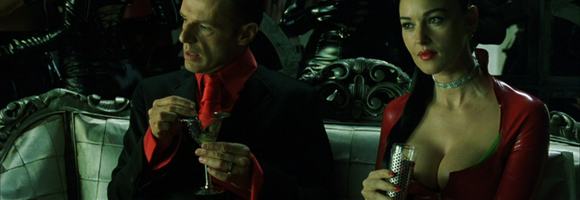manuscript-day 208 of 100
‘Prior to the twentieth century, persons suffering from mental illness were thought to be “alienated,” not only from the rest of society but from their own true natures. Those experts who studied mental pathologies were therefore known as alienists,’ historian and writer Caleb Carr clarifies in a preliminary note to his 1994 thriller novel. In ‘The Alienist’ Laszlo Kreizler, psychiatrist, hunts down a serial killer—the story taking place in a hardly gaslit New York City of the year 1896. Not only Theodore Roosevelt makes a cameo appearance, but also Franz Boas, American anthropology’s founding father of German descent. Boas being in the novel, like the many references to the works of psychologist and philosopher William James, is not mere decoration instilling the flavour of the period, but a decisive instrument of marking an intellectual transition. The transition from labelling the ‘alien’ as hopelessly lost and to be treated accordingly—because it surely is dangerous, to the notion, that the ‘other,’ even the pathological!, can be understood. Matchingly Stevie Taggart, the narrator of ‘The Angel of Darkness,’ the sequel to ‘The Alienist,’ relays, ‘that Nature’s domain includes every form of what society calls “unnatural” behavior; that in fact, just as Dr. Kreizler always has said, there’s nothing truly natural or unnatural under the sun.’ (Carr 1999 [1997]: 10)
eldredge variant
To my eyes ↵the ‘Eldredge’ is an absolute beauty, but the solution Jeffrey Eldredge chose for the final move does not exactly leave us with a ‘knot’ in the technical sense of the term. He simply tucks what is left of the narrow end of the tie away under the collar and the loop the tie forms around the neck. That way we depend on the pressure the loop around the neck exerts on the collar for the whole structure not to come apart. To improve this situation I added two ‘through-the-loop’ movements to Jeffrey’s invention. Translated to Fink-Mao notation, my ‘Eldredge’ variant reads like this:
Ri Co Li Ro Li Co Ri Lo TCi Ro Ci Lo TCi
‘T’ means ‘lead the narrow end through the loop you just made,’ the exact same meaning Thomas Fink and Yong Mao had in mind, when they introduced the ‘T’ to their notation. There is no space between ‘T’ and ‘Ci,’ because it is one move— make sure that you go ‘through’ and really ‘center in’ before pulling the loop closed, else disaster is imminent. It requires a bit of concentration and inner quietude to tie, but once done you will have a luscious triangular knot of silk under your chin, which can not disintegrate. Due to the optimal symmetry Jeffrey’s sequence supplies, the finished knot is open to being sculpted to perfect shape. I found it enough for me to go with both thumbs under the knot, to put all the other fingertips on top of the knot, and to slightly press the knot flat.
Now, the two added moves mirror the pattern visible atop the knot. Due to the asymmetry of the visible structures on the front of the knot, starting with the wide blade to the right or to the left, no more is negligible and may even gain sartorial meaning. The most common pattern found on ties are diagonal stripes. The historical background of the stripes is a thing in itself—for now only so much: In Europe it is common, that the stripes, when looked upon from the front, run from the lower left, to the upper right. Given that we are used to read from the left to the right, the stripes are pointing upwards. In the United States of America, to the contrary, the stripes usually point downwards—no metaphorical allusion to politics or even economics intended.
The orientation of the structure on the ‘Eldredge’ is dominated by the upper most diagonally running edge of the tie’s fabric. If it is pointing upwards or downwards depends on how you start tieing the knot—with the wide blade to the right, or to the left, and on your choice between the original ‘Eldredge’ and my variant of it with the two through-the-loop moves added. No matter if you wear New-World or Old-World style diagonal stripes, in both cases you have to decide if you want the diagonal on your ‘Eldredge’ follow suit, or counter. Decision made, you have to choose the according procedure of tieing the knot.
Jeffrey’s subterfuge of tucking the tip of the narrow end away under the collar frees you from any worries about the narrow end showing. Granted, there is the philosophy, that a tie has to be able to move freely. I agree—to a certain degree—in respect to the wide blade. Nevertheless some people are of the opinion, that the narrow end should be free, too. But then again every decent tie has a ‘lead’ on its back, a small sewn-on horizontal loop meant for sticking the narrow end of the tie through it, so it won’t get visible by accident. From this I deduce, that it is sartorial consensus, that the narrow end should stay hidden. Now to the wide blade.
Due to the ‘Eldredge’ being of the largest order of magnitude possible with a regular tie, and due to it being an almost perfect equilateral triangle, the tie’s wide blade blossoming out of the sharp vertex pointing downwards, a broad tie—maybe even a ‘kipper’ of 1970s fame—is mandatory for achieving æsthetical proportions. You may object, that kipper ties are out of fashion, but a 1950s narrow tie, like they recently seem to have come back to fashion, emerging from the voluminous ‘Eldredge’ just looks plainly ridiculous. I just can say, remember Lord Whimsy’s dictum: ‘Fashion is for those who have yet to understand style.’
the eldredge
It is uncanny, the development is still unfolding. After I learned about the inverse tie knots, invented by edeity, and clearly transcending Fink & Mao’s 85 ways, I made some calculations—of course by means of the formulas devised by Fink & Mao, and spent a thought or two on the matter. The original ‘Edeity’ knot and the ‘Hen Tie’ are of size 11, comprising 4 center moves. Formula (15) (Fink & Mao 2000: 115) teaches us, that there are 80 knots within this class. Edeity’s ingenious idea to wind the narrow end around the tie’s wide blade, instead of the standard procedure the other way round, made possible size 11 knots, and showed the way to a lot more knots. In theory you can tie every regular knot inversely, which would double Fink & Mao’s 85. But only inverse knots with odd size are acceptable. If you tie knots of sizes 2, 4, 6, 8, etc. inversely, then the seam of the tie would either be on the front of the wide blade, or on the outside of the knot. The former is plainly unacceptable, the latter might be a matter of debate. Because of this, inverse knots of sizes 10 and 12 are not feasible. 13 again would be possible, but back then (see ↵merovingian ties and ↵more merovingian ties) I deemed them to be impossible with a tie of regular length, hence I dismissed the thought. Well, Jeffrey Eldredge dared it—watch ↑How to tie an Eldredge Knot on YouTube [embedding disabled by request].
In the movie Jeffrey does not follow the convention of having the wide blade to the right, seen from the wearer’s point of view. Hence you can take the video as what you would see in the mirror when tieing. Accordingly I mirrored Jeffrey’s moves for the Fink-Mao notation. Here is ‘The Eldredge:’
Ri Co Li Ro Li Co Ri Lo Ci Ro Ci Lo Ci [T]
The knot is of size 13 and comprises 5 center moves—this class contains 240 knots. ‘The Eldredge’ is of optimal symmetry 0, and balance 2. The optimal balance achievable in this class would be 1, but I am not yet sure, if—due to the visible inverted-V structures characterizing the inverse knots—this parameter of æsthetics is applicable here. The ‘T’ for the final through-movement I put in square brackets, because Jeffrey actually does not do it. Instead he tucks away the tip of the tie’s narrow end under the collar. There is not much left of it anyway. Fink & Mao added the subscript suffix ‘on’ for ‘Onassis’ to the Lo Ri Lo Ri Co T Ri Co variant of the Four-in-hand, worn by the late Greek shipping tycoon. So, in the future I might substitute the [T] by an ‘E,’ or ‘ET’ for ‘Eldredge tuckaway.’
So, now you know about ‘The Eldredge,’ to my knowledge the latest in hitches worn around the neck. But stay tuned, as I still have something up my sleeve, maybe ‘the last of the tie knots’ …
grand theft childhood
Finally …
The book is a straightforward and clear scientific elaboration of, and argument for, what ihatesheep ↵brought to the point in 2006: ‘If playing GTA is all it takes for your child to go out and murder prostitutes, then there are far, far bigger problems that you probably need to address.’
running chrome

There is a new browser around—the beta version of ↑Google Chrome was released yesterday. It is damn fast, I have to say. And there is a ↑comic book about it.
car on earth

Believe it, or not, but I found ↵my own car on ↑Google Earth, the successor to ↵World Wind, which nobody seems to know anymore.
vulcano by hP

Just a minute ago I received the latest e-mail newsletter from the ↑CGSociety. The top news in it is, that the CGSociety adopted ‘↑Game-Artist.net, the game artist’s web portal. Now there will be even more game-art eye-candy for the industry, under the CGSociety mantle. Drop by and check out Game-Artist today. For those already there, welcome!’ Immediately I went to the forums, headed down to the work-in-progress (WIP) section—within all forums of that kind the most interesting department to me—and clicked on the top thread, ↑Crysis Map ~ Operation Codename: Vulcano. Droolingly staring on the gorgeous screenshots I thought, ‘this reminds me of the ‘↑Max Payne 2‘ (MP2) mod ↵Mission:Impossible—New Dawn. Hell, how much the game-engine capabilities have changed since those days.’ Next I looked on the name of the creator of this fabulous looking ↵Crysis-map … it is my old friend from the Max-Payne community ↑Hélder ‘hP’ Pinto! Congrats—u r da man↑!!!!!1111oneoneeleven Plus, he ↑turned pro, too! Even more congrats!

more merovingian ties
After having published ↵merovingian ties—beyond the 85 knots of Fink and Mao, I started to contact some of the involved protagonists. ↑Lord Whimsy was the first to answer and confirmed a suspicion of mine. To my question on how he discovered the knot, Whimsy answered: ‘If memory serves, I found a few sources online (I believe it was a pdf file somewhere). After some failed attempts of my own, I finally figured it out.’ So, it seems that Whimsy got hold of the same tutorial by edeity, ↑published at zgeek, with which Henry Hu started out. Like Henry, Whimsy, too, did not get to grips with the scarce information of the tutorial, and—again like Henry—created his own solution. Now it is on me, to correct an error I made. The sequence in ↑Henry’s original Hen Tie video tutorial is not the same as in Lord Whimsy’s ‘↓The Merovingian‘ tutorial.
Henry Hu’s original Hen Tie:
Ri Co Ri Lo Ci Ro Li Co Li Ro Ci T
Lord Whimsy’s Merovingian:
Ri Co Ri Lo Ci Lo Ri Co Ri Lo Ci T
The detection of this difference once more proofs the usefulness of the (R, C, L) notation from the ↑Fink-Mao taxonomy.
Henry Hu already replied, too—and even more so. First he confirmed what I had written, and then posted a ↑video response at YouTube, again showing off how to knot the Hen Tie (that is the official spelling, by the way), this time using a special tie, customized by himself. Investigation of the whole matter continues—stay tuned.
P.S.: I love the life-feeling of the video, especially the interruption caused by Henry’s cell phone—in my opinion the /baywatch-gesture is one of the most valuable pieces of content within ‘↑Second Life‘ (SL).
anthropology coming of age
welcome to the 21st century

Since quite a time ↵I was eagerly awaiting ‘↑Coming of age in Second Life: An anthropologist explores the virtually human‘ by ↑Tom Boellstorff—it just arrived with yesterday’s snail-mail, so I had not yet the chance to read Tom’s book from front to back cover. Until now I only read chapter 1 ‘Subject and scope,’ plus a dozen or so random paragraphs from throughout the book. Hence I am not yet qualified to deliver a review, instead I will jot down just some thoughts.
Although ‘↑Second Life‘ (SL) is not the focus of my own work, what I saw so far of Tom’s text again instilled that somewhat ambivalent feeling. To make it clear from start on: I am very much with what Tom wrote. My ambivalence stems from oscillating between the poles ‘Gosh, if only I had been faster!’ and ‘Yes! I am on the right tracks.’ So much on my personal reception of ‘Coming of age.’
Others had been faster—at least when it comes to reading the book ;-)—and it already triggered some discussion within that part of the anthropological community which is visible online. At ↑Savage Minds there are two reviews: ‘↓Ethnography of the Virtual‘ by Kerim Friedman, and ‘↓More on Coming of Age in Second Life‘ by Alex Golub, plus a follow-up, again by Kerim: ‘↑The Presentation of Self in Virtual Life‘. In the wake of those quite a number of comments spawned, including in-depth replies by Tom Boellstorff. Furthermore the topic is currently debated on the medianthro mailing-list—Tom replies in there, too. No matter the stance of any single anthropologist towards SL, online phenomena in general, or Tom’s book in particular, the issues have forcefully reached anthropology, are no more spat upon, but are seriously discussed within the discipline—anthropology is coming of age in the 21st century. Maybe not exactly as he envisioned, but what Arturo Escobar encouraged in his seminal article (↵1994) finally arrives … Tom’s book did and does quite something for that.
Every anthropologist who in the future wants to talk or write about SL, or non-↑MMORPG ‘online persistent state worlds’ in general, has to read ‘Coming of Age.’ In my view there is a trinity of absolute-must books on the topic, all of which were published this year:
↑BOELLSTORFF, TOM. 2008. Coming of age in Second Life: An anthropologist explores the virtually human. Princeton, Oxford: Princeton University Press.
↑MEADOWS, MARK STEPHEN. 2008. I, avatar: The culture and consequences of having a second life. Berkeley: New Riders.
‘The making of Second Life’ strives to achieve for the understanding of SL, what ↑David Kushner‘s ‘Masters of Doom’ (↵2004 [2003]) did for ↑first-person shooter computer games—although, in my opinion, Au’s book does not reach the heights of Kushner’s. Despite Au once being—as SL’s ’embedded journalist’—on Linden Lab’s payroll, his book is far from hailing mumbo-jumbo of the marketing kind. Instead it furnishes in-depth understanding of SL’s history and background.
Mark Stephen Meadows is an early adoptor in the ranks of ↵John Perry Barlow and ↑Howard Rheingold. ‘I, avatar’ is outstandingly designed—Meadows is a portrait artist and author by profession—and from all physical books on the topic does by far the most justice to SL in terms of visual representation. In terms of content, it until today is the best I read on the issue of ‘the avatar,’ which Meadows does not restrict to the graphical representation of the user-controlled agent in SL. He understands it as a term for all kinds of online manifestation of a human individual’s personality. For example, in his book he also deals with interaction at YouTube—absolutely enlightening. The book as a whole qualifies as ‘experimental ethnography,’ a genre so much asked for since the times of ‘Writing culture.’
merovingian ties
beyond the 85 knots of Fink and Mao
Most of you have not noticed, I presume, because when the ↑character ‘Merovingian’ (Lambert Wilson) first appears in ‘↑Matrix Reloaded‘ (2003), your eyes were on ↑‘Persephone’ (Monica Bellucci) at his side. But, if you would have watched the Merovingian, and would have slid down your gaze from his face a bit—not quite as far as you practiced on Miss Bellucci—you would have noticed, that the man sports a decidedly strange looking knot on his necktie. Meanwhile there is a knot around which seems to resemble the one in the movie, and indeed is called the Merovingian [knot]—a tie-knot named after a character out of a cyberpunk movie of course triggered my interest, so I set out to clarify the matter. Contradicting information found on the Web made me review the movie and take some screen captures:
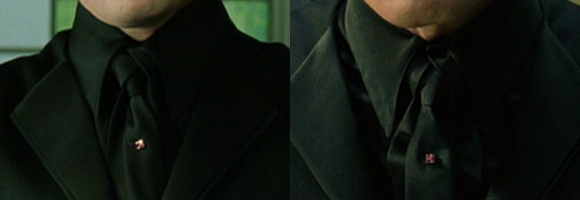
Both pics stem from ‘Matrix Reloaded’—the one to the left belongs to the scene in the restaurant where the Merovingian makes his first appearance, the one to the right from a scene a bit later, when, after Persephone’s betrayal, he storms into the Château. It is a bit hard to see, because—↵just like Fantomas—the Merovingian has it all in black: suit, shirt, and tie. But, with almost certainty, what he wears in ‘Matrix Reloaded,’ is a turned-around reverse Windsor. Allow me to explain. Looking closely you will discover two distinct features to be seen. First, the knot itself is covered by two diagonally overlapping strands of the tie. Second, the narrow end of the tie is in front of its wide-blade end—the other way around as usual. A regular Windsor-knot looks exactly like that, when viewed from ‘behind,’ like ‘out of the chest,’ that is. With one difference: When you look at a Windsor from behind, you also will see the centre seam of the tie. But that is not the case in the movie, hence the Merovingian’s tie must have been tied ‘in reverse.’
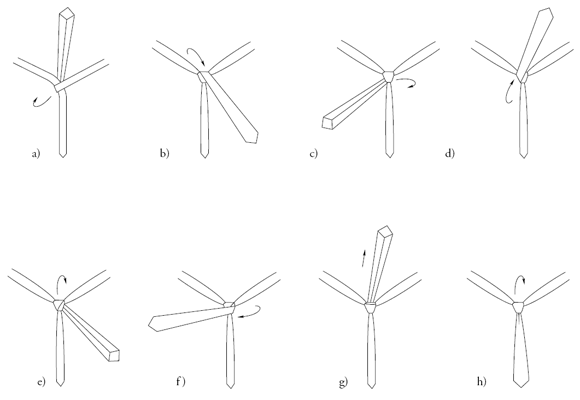
Regular tieing of the Windsor implies, that on starting out you hang the tie around your neck, wide blade to the right, and the seam-side towards your body. Reverse tieing means placing the tie with the seam away from your body. In order to achieve the knot seen in the screen caps, you have to reverse tie a Windsor, then take it off over the head, turn it around, and then pull it over the head again. Which is, to say the least, an inelegant, awkward procedure. As far as I remember Gianni Versace, at about the beginning of last century’s 90s, sold a tie accompanied with a tutorial of how to knot it the described way, so that the narrow end finally was in front. Back then a schoolmate of mine sported it at a club one night, and told me about it. I contacted him on this yesterday and he confirmed my memory, adding that it was a night-blue tie with a black Versace-Medusa, from wherever he is at the moment, checking his Blackberry—he became one of those ↵top-notch Nazgûl.
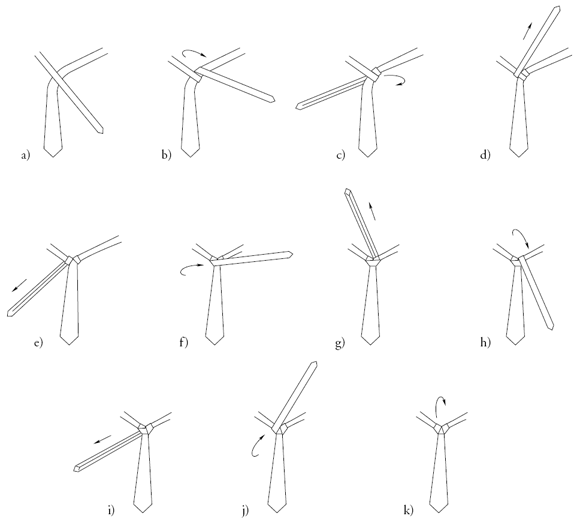
As mentioned above, meanwhile there is a knot around, which is referred to as ‘The Merovingian’—at least by ↑Lord Whimsy aka ↑Victor Allen Crawford III in his excellent ↑tie knot tutorials (scroll down to ‘No. 14: The Merovingian’ and download the stylishly designed .pdf), and ↑by the German Wikipedia. The origin of and story behind this knot is what I am after, although it is not the knot to be seen in ‘Reloaded.’
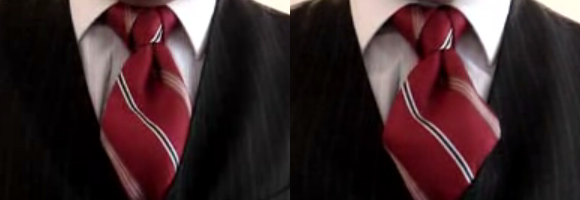
The movie was released on 15 May 2003—on 28 September 2003 edeity posted a .pdf-tutorial at zgeek.com, wherein he explained how to tie a knot he had envisioned. Years later New-York based banker and magician Henry ‘SimplyJustHen’ Hu got hold of the tutorial, but could at first not decrypt the four pictures, and hence thought the tutorial to be faulty. So he created his own solution, which he posted on 16 February 2007 at YouTube as a video tutorial—↑you can see a true master at work there. Alluring to the abbreviation of his first name, Henry christened it the ‘Hen-Tie,’ pulling of a pun on ‘Hentai’—in the West a common term referring to Japanese pornographic anime, manga, and computer games. ‘Hen’ alone in Japanese means ‘weird,’ so one can read ‘weird tie’ also.

At first SimplyJustHen was of the opinion that he had recreated the Merovingian’s tie knot, but on 31 March 2007 a video response on YouTube by frank77dk, called ↑‘Matrix Reloaded Tie,’ clarified the matter. Frank expertly explains and demonstrates how to do the knot, and even uses a special two coloured tie to get the tutorial clear as glass. His comment:
This is the tie worn by the Merovingian in the restaurant. I’ve been wearing this tie since I first saw it in the theatre, and have been calling it the Tarenta Knot, i’ve searched and searched for this tie everywhere and for what its called, and have found nothing. I don’t want to claim what isn’t mine, so if someone can come up with the legit name, i’ll use that, until then, it’s the Tarenta Knot to me ;)
About two months after the initial posting of SimplyJustHen’s video tutorial edeity and he agreed, that the knot in the video indeed was the one described in edeity’s .pdf tutorial—Hen immediately gave due credit and changed title and description of his video.
So, as it stands, what the German Wikipedia and Lord Whimsy refer to as the ‘Merovingian’ rightfully should be known as the ‘Edeity.’ The Merovingian himself never wore the tie-knot which now bears his name. Misnoming has quite a tradition, when it comes to tie-knots. The Duke of Windsor never wore the according knot. He tied his ties in a Four-in-Hand, but used unusually thick, upholstered ties, resulting in voluminous knots. Most probably the Windsor-knot was invented in an attempt to emulate the Duke’s hardware-supported style. There is also some confusion in respect to the ‘Pratt,’ which sometimes is referred to as the ‘Shelby.’ In fact this knot was invented by Jerry Pratt, a member of the US chamber of commerce. He regularly wore the knot for about twenty years, then showed it to his friend, television presenter Donald Shelby. Via the latter the knot became popularized, and the name at least partially stuck.
All right, we know now what kind of knot the Merovingian sported in ‘Reloaded’— a turned-around, reverse full Windsor. But what about the Edeity/Hen-Tie now known as the Merovingian? It is an inverse doubled up full Windsor. In this context ‘inverse’ means that the wide blade of the tie is ‘passive,’ meaning that it remains in position, while the narrow end is wound around it. In contrast all traditional tie-knots are bound by winding the broad end around the narrow end. More precise, using the Fink-Mao taxonomy, the Edeity/Hen-Tie/Merovingian is a knot of size: 11, symmetry: 1, balance: 3, and knotted status: yes—if I haven’t made a mistake anywhere. Its tieing sequence in (R, C, L) notation is:
Ri Co Ri Lo Ci Lo Ri Co Ri Lo Ci T
I have not added a super- or subscripted ‘inv’ for inverted, because the starting of the sequence with Ri already implies this, as regular tie-knots only can start with Lo or Li … What the hell I am talking about, you ask?
Well, in their book ‘The 85 ways to tie a tie,’ (Fink & Mao 2001) physicists ↑Thomas Fink and ↑Yong Mao
introduced a mathematical respresentation of tie knots and proved that, with a conventional necktie, there are exactly 85 possible ways to tie it. Of these, just over a dozen are sufficiently handsome or different from each other to be worn. These include the four traditional knots—the four-in-hand, the Nicky (a derivative of the Pratt knot), the half-Windsor and the Windsor—and a number of previously unknown knots.
In order to understand what I was babbling about above, Fink & Mao’s mathematical representation and taxonomy can be scrutinized in the two journal articles (Fink & Mao ↓1999, ↓2000), out of which the book grew, and on the ↑according part of Thomas Fink’s website. Best of course is, to buy their book—have not got it myself yet, but just ordered it. Hence, in the following I refer to Fink & Mao 2000.
The two men set out to settle the matter of tie-knots once and for all. But they based their work on some limiting axiomatic assumptions, thereby introducing a bit of cultural bias. My argument is, that the Edeity/Hen-Tie/Merovingian is not an element of traditional mainstream occidental culture, but an instance of the cybercultureal. For this context let us have a look on Fink & Mao’s assumptions. On the hardware side only ‘regular ties’ are taken into consideration. This is fine cyberculture-wise, too, because it has that ‘↵Origami air,’ creating the unusual out of basic, untampered-with material. Reverse knots are mentioned by them, but not explicitly those of the ‘Reloaded’ kind with the narrow end to the audience. I guess this is just too far away from societal consensus. Even my Nazgûl friend said, that he found the reverse Versace-thingie awfully cool at the end of the 1980s, but today smirks on it. Anyway, what the Merovingian wore is in Fink & Mao’s table, because it is just a regular tie-knot turned around. So, the reverse versions of regular tie-knots are covered by Fink & Mao, but the inverse knots are not. Here the two stick close to tradition, because it simply has been bequeathed, that when tieing a tie, you start out with the wide blade to the right and wind it around the narrow end. Principally the regular and inverse knots topologically would be the same, if the tie had no orientation, the ends would not be distinguishedly marked. But a regular tie is oriented, it has a wide and a narrow end, and Fink & Mao are perfectly aware of that: ‘The finite length of the tie, as well as aesthetic considerations, suggests an upper bound on knot size; we limit out exact results to h [smaller as or equal to] 9′ (Fink & Mao 2000: 113)—h being the number of half-winds, the ‘size’ of the knot. Herein lies the reason why they come to a result of 85 knots and not more. Size 9 is a sensible limit, not just because of the fact, that after a certain number of winds you simply have nothing more to wind around, but because of the wide blade becoming ever wider until the tip starts, the results begin to resemble a mangled football, but no more an acceptable tie-knot. Enter the Edeity/Hen-Tie/Merovingian: Its size 11 is possible, because the in this case active narrow end does not build up volume as fast. In terms of volume it is not larger than the Windsor (size 8), and hence still æsthetically acceptable. Furthermore, balance and symmetry are all right as well, and, like with traditional knot-ties, the wide blade is to the front, and the seam of the tie to the back. So, it is a new knot, doing justice to Fink & Mao’s—and occidental society’s—criteria, but going beyond their 85 specimen. Naturally, the visible inverted-V structure is a matter of debate, but, in the words of Fink & Mao, I leave that to the reader’s sartorial discretion. Me personally, I deem the Edeity/Hen-Tie/Merovingian to be beautiful—especially, of course, because of its background. Judge for yourself, here are some renditions of it by Yours Truly—I used ties of different lengths and materials, from polyacryl to pure silk:
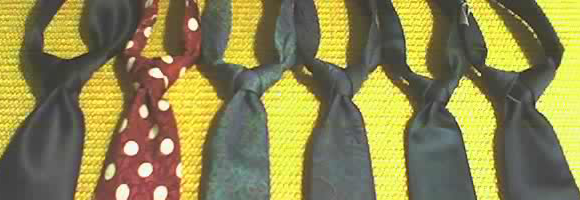
Now for why I take the new knot to be a cybercultureal tidbit. First of all it has been created in the attempts to reverse engineer the tie knot a character sported in a cyberpunk movie. True, reverse engineering is an important, but not an exclusive element of cyberculture—as we saw, the Windsor knot, too, was most probably invented by the attempt to recreate a particular style. Hence you could interprete this as a continuity in the tradition of the invention of tie knots, but the protagonists were not aware of this.
My second argument asks for the motivation, for the point in desiring to wear what the Merovingian wore. The principles of association, allusion, and referencing are core elements of cyberculture—for the outsiders mostly invisible, cryptical at best, for the insider and his peers demarcations of identity and ultimately communitas. Henry Hu himself said that the knot is ‘a nerd thing, a geek thing,’ … and that it ‘looks like alien penisses,’ to complete his hentai allusion. Wearing this offline ↑easter egg the knot is, already constitutes a ↑thrill to ‘the geek,’ a source of positive, identity-congruent sentiment. Like pouring your tea out of a Melitta original of the ↑Utah teapot would be.
My assuming, that the majority of the younger online generation loathes wearing ties, is an educated guess, but highly probable. There are multiple reservations against ties, but by means of its background, the Edeity/Hen-Tie/Merovingian got metaphorically so powerful, that it might serve as a blockbuster. Here is an excerpt from what cyberpunk-drenched computer game pundits and expert Second-Life content creators ↑Detect Surface and ↑acid Zenith—the latter cyber goth on- and offline—remarked, after I had told them about the knot:
[2008/06/04 14:46] acid Zenith: if i ever wear a tie,,, wich i doubt
[2008/06/04 14:46] acid Zenith: i will do that
[…]
[2008/06/04 14:49] Zephyrin Raymaker is tempted to write a blog entry on said knot
[2008/06/04 14:49] acid Zenith: do it
[2008/06/04 14:49] acid Zenith: ill know where to go when i need it then
[2008/06/04 14:49] You: …. so be it
[2008/06/04 14:49] acid Zenith: also its interesting
[2008/06/04 14:50] Zephyrin Raymaker starts in-depth research
[…]
[2008/06/04 18:14] Zephyrin Raymaker practices the Merovingian knot
[2008/06/04 18:15] Detect Surface: lol thats a good knot, I’ll wear that around the house
[2008/06/04 18:15] Detect Surface: and cook with it nakkid
[2008/06/04 18:15] You: Ha ha ha ha ha ha ha ha ha
[2008/06/04 18:15] acid Zenith: kinda makes me wish i had an office job, just so i could do that on the tie……. on second thoughts,,, lo fuck that
[…]
[2008/06/04 18:15] acid Zenith: can u imagine me in an office?
Third, by means of the work of Fink and Mao, tie knots have been popularized as topological artefacts—for those ‘in-the-know’ wearing a tie now means sporting a piece of mathematics around the neck.
Fourth, the last two newly invented knots before Fink & Mao, the Windsor and the Pratt, were popularized via the traditional mass medium of the newspaper. The Edeity/Hen-Tie/Merovingian was made known to the public via the Internet—first via edeity’s .pdf, then via SimplyJustHen’s video tutorial on YouTube. As of today the latter has been viewed approximately 87,000 times.
But that is not yet the end of the story, as the Merovingian, and Persephone!, both reappear in ‘↑Matrix Revolutions‘ (2003), the third part of the trilogy. This time he sports a red tie and shirt, matching Miss Bellucci’s … erh … tight dress and lipstick. He sports another knot, enormous and cylindrical, far from the elegance of the Edeity/Hen-Tie/Merovingian:
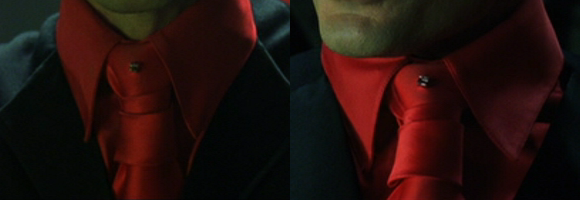
Although I do not know what it exactly is, it is nothing extraordinary, tech-wise. You can achieve a similar result by tieing any of the narrower regular knots, then winding the narrow end around it two times, and finally tug it away behind.
One last thing. The René-Magritte style cover of ‘The 85 ways’ features a surreal impossibility:

The tie’s European style stripes (pointing upwards to the wearer’s left shoulder) are oriented the same way on the tie’s blade and on the knot. This would only be possible when using a special tie, on which the orientation of the stripes reverses at a certain point. Frankly, I am tempted ↑to make such a tie, only to see if anyone notices the impossibility. That would be the only reason for me to, in the future, wear a tie and not tieing it the Edeity/Hen-Tie/Merovingian style.
Ah, yes, just to go full circle—pun not intended—here is Persephone:
